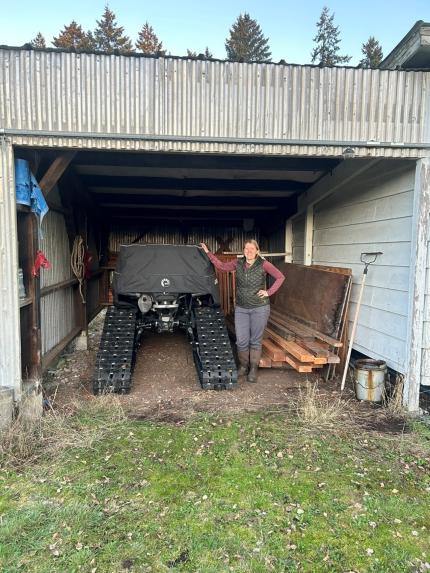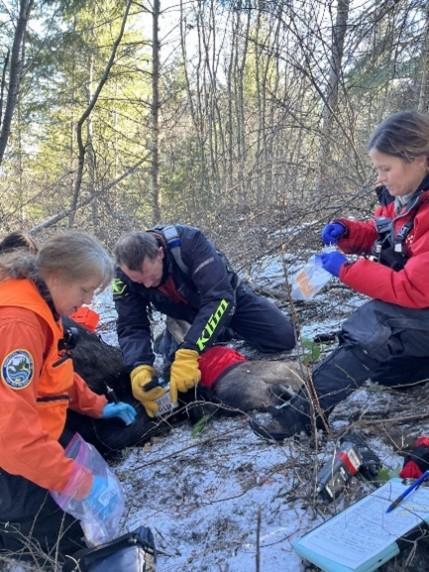
Wildlife Program report: Feb. 16-28, 2024
Managing Wildlife Populations
Moose Capture Effort: Biologists Lowe and Brinkman spent two days working with other Washington State Department of Fish and Wildlife (WDFW) biologists to aerially capture and collar moose in District 2. The first day focused on searching and capturing moose in the Spokane West Hunt Area, and the second day moose were captured in both the Mt. Spokane North and South hunt areas. A total of 13 cow moose were captured and collared during those two days of effort (six in Spokane West and seven in Mt. Spokane North/South). This is the first year of a multi-year project to better understand moose population dynamics within their range in northeastern Washington (Districts 1 and 2).

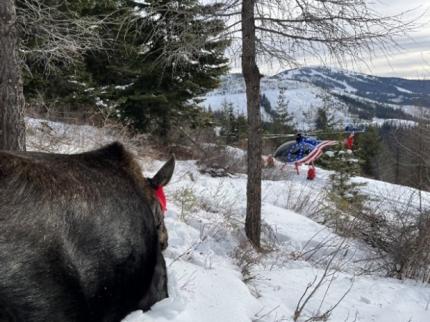
Forest Grouse: Biologists Lowe and Brinkman participated in the eastside “wing-bee”, an event where biologists and other Washington Department of Fish and Wildlife (WDFW) staff members examine grouse wings and tails collected from wing barrels during the 2023 forest grouse hunting season. Grouse hunters are asked to deposit a wing and tail from each harvested grouse into these wing barrels. After the hunting season, biologists sort through the wings from each district and identify the species of grouse wing submitted before determining age and sex of the bird, when possible.
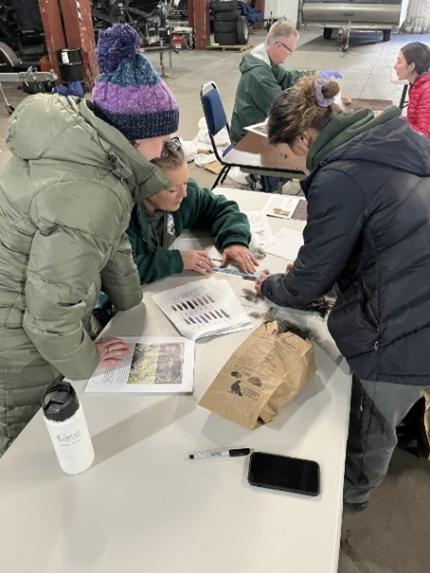
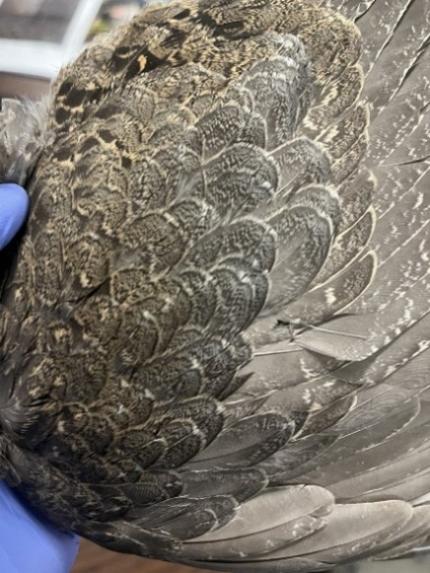
Hartsock Golden Eagles: Wildlife Area Manager Dingman observed the adult pair flying in the territory and one adult landed in the nest with a stick. This is the first year the pair will be using this nest site and quite a bit of new material has been added to the nest.
Mountain Lions: Wildlife Area Manager Dingman came across video of a female mountain lion with two kittens on the W.T. Wooten Wildlife Area headquarters security cameras. The video is from Friday, Feb. 23 at 4:18 a.m.
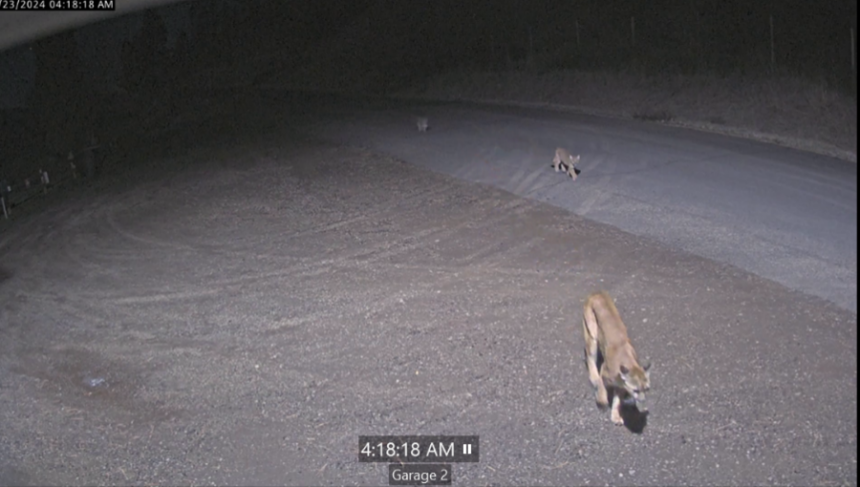
Providing Recreation Opportunities
Early Spring Opener: Region 1 Access Manager Dziekan reports a few access areas have been prepped for the March 1 opener. The access areas that are prepped are Liberty Lake, Deer Lake (District 1), and Amber Lake. The picture below is from Liberty Lake after Dziekan cleaned the toilets. The gate at Liberty Lake has been locked open. The two other access sites do not have gates to lock open.
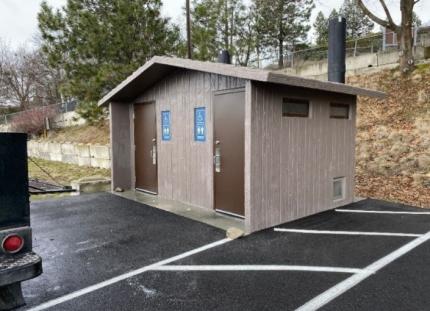
Access Areas: Access Manager Heimgartner serviced access sites at Heller Bar and the Grande Ronde River on Monday. Heimgartner serviced sites at the W.T. Wooten Wildlife Area on Thursday. Natural Resource Specialist Whittaker assisted Heimgartner with making a welding repair on his tractor back blade on Thursday afternoon.
Providing Conflict Prevention and Education
Elk Damage: Wildlife Conflict Specialist Kolb responded to a report of elk damage in the Cheney area. The reporting party was upset about what they described as $10,000 in elk damage to a round bale haystack. Kolb placed 300 feet of netting style electric fence and turbo fladry around the haystack. A zon cannon was also provided to the producer in addition to pyrotechnics.

Elk Crop Damage: Wildlife Conflict Specialist Harris met with a producer in Spokane sustaining damage to haystacks and winter wheat fields from two different elk herds. Harris loaned a paintball gun and bird banger pistol to the producer to aid in their attempts to haze the elk off the haystack at night. Harris also worked with volunteer coordinators to organize a master hunter hazing effort to assist the producer with hazing. Harris and Private Lands Biologist Nizer will meet with the producer next week to discuss Damage Prevention Cooperative Agreement and public hunting access for his winter wheat fields.
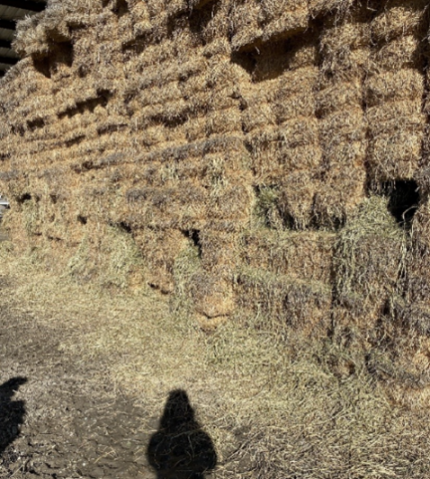
Conserving Natural Landscapes
Boundary Stock Fence: Natural Resource Technician Meisner, Natural Resource Technician Hammons, and Natural Resource Scientist Whittaker continued replacing aging stock fence at Boozier Ridge on the George Creek Unit of the Asotin Creek Wildlife Area. The fence borders a private property ranch with an active grazing program.
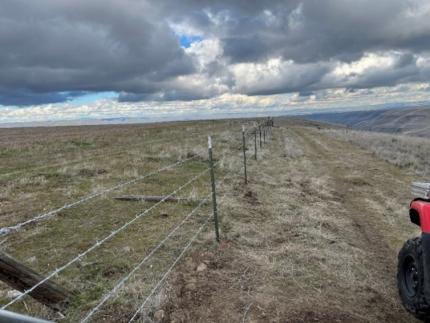
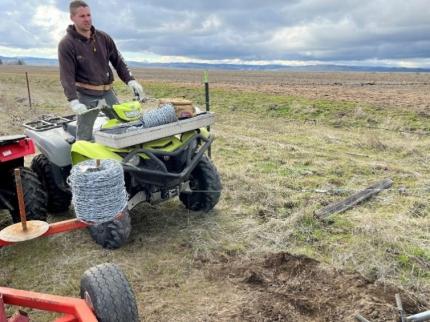
Gate Found Open: From a tip received over the previous weekend, Wildlife Area Assistant Manager Palmer found that the Trout Lake Road winter range gate was open, when it should have still been locked shut. The Washington Department of Fish and Wildlife (WDFW) lock was also gone. Palmer checked the roads beyond the gate to determine the extent of travel and to ensure no vehicles remained behind the gate. He also finished cutting a tree out of the road, which the illegal accessors had cut just enough to squeeze past. Palmer checked with the Colville National Forest staff members about the gate as well, but they had no knowledge of the gate being opened. The gate is now locked shut with a WDFW lock.
Providing Education and Outreach
Hunter Education: Wildlife Conflict Specialist Kolb assisted with the instruction of 14 students who completed their hunter education field day at the Waitsburg Gun Club.
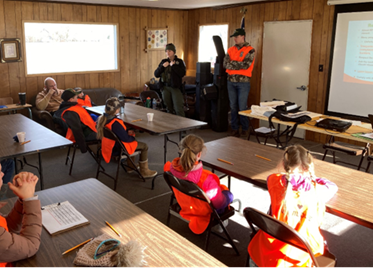

Spokane Great Outdoors and Golf Expo: Region 1 Access Manager Dziekan worked a shift at the Spokane Great Outdoors and Gold Expo over the weekend. Dziekan’s shift lasted about three hours, and it was busy almost the entire time fielding a variety of questions. Conveniently though, most of the questions were regarding access. People wanted to know where to go for different outdoor activities, primarily hunting and fishing.
Biologist Brinkman gave a presentation at the Spokane Great Outdoors Expo about recreating safely in bear and cougar country. The talk was attended by about 40 people.
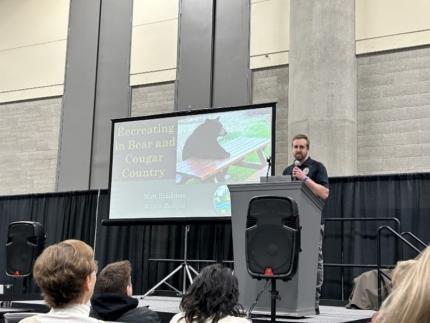
Grizzly Bear Train the Trainer Workshop: Wildlife Biologist Prince attended a workshop organized by the Selkirk/Cabinet-Yaak IGBC Subcommittee information and education task group. The workshop was led by a communications and outreach specialist from Montana Fish, Wildlife, and Parks. Workshop participants learned how to deliver bear education to audiences of different ages and identities. They learned why consistency is important in bear education and they received tools and materials to use in educational presentations. Each participant was also able to give a 5-minute presentation using their newly learned skills and receive feedback from the group.
Conducting Business Operations and Policy
Tucannon U.S. Forest Service Project Tour: Wildlife Area Manager Dingman, Senior Restoration Specialist Karl, and some U.S. Forest Service staff members toured some U.S. Forest Service (USFS) projects on the Tucannon. Dingman and USFS staff members will work together to place large boulders on the property line in the USFS Tucannon Campground where Washington Department of Fish and Wildlife owns land that USFS has been charging people to camp on.
Washington Department of Fish and Wildlife and U.S. Forest Service staff members reviewed the designs/plans for replacing the Little Tucannon Bridge with a longer-spanning bridge. The new bridge would be raised up to allow for larger flow events in the Little Tucannon without washing the bridge out every time. They reviewed and discussed the proposed large wood structures that will deflect the Tucannon River away from Tucannon Road near the Watson Lake parking area where the road was washed out during the 2020 flood event.
Washington Department of Fish and Wildlife and U. S. Forest Service Annual Meeting: Wildlife Area Manager Dingman participated in the annual meeting of Washington Department of Fish and Wildlife and the Umatilla National Forest U.S. Forest Service staff members. These meetings are always a good way to catch up on all of the projects going on and see everyone in person.
Sherman Creek Wildlife Area Facilities: Wildlife Area Assistant Manager Palmer mounted a metal storage box and placed a new Automated Emergency Defibrillator (AED) in it, at the shop at Sherman Creek Wildlife Area. This activity is one result of the early February safety stand-up meeting held at the Sherman Creek Wildlife Area. The other AED will be mounted on a shelf at the Sherman Creek Wildlife Area office once the ordered shelving arrives.
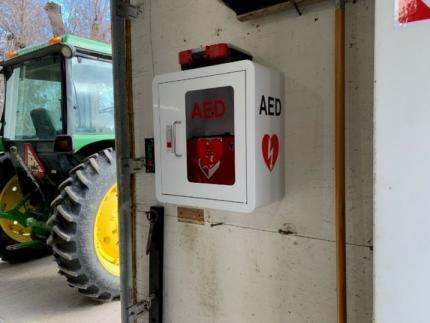
Managing Wildlife Populations
Greater Sage-grouse: Biologists Eilers and Jeffreys and Technicians Hara and Force surveyed greater sage-grouse leks (communal display grounds for males). Biologists across Douglas County will be surveying for sage-grouse and Columbian sharp-tailed grouse, both of which are classified as endangered by the State of Washington. They are monitoring known current and historic leks to count birds for the purpose of generating a population estimate.
Biologists and other Washington Department of Fish and Wildlife (WDFW) staff members and agency partners will be conducting an intensive search for previously unknown leks by driving county roads and stopping every half mile to get out and listen for the vocalizations grouse often make while displaying. Douglas County currently has the greatest abundance of greater sage-grouse in Washington, but populations are declining. With this year’s increase in survey efforts, biologists hope to find more lek sites for both species and locate leks that were displaced by the Pearl Hill Fire. For more information on greater sage-grouse in Washington, visit the Washington Department of Fish and Wildlife website at Greater sage-grouse | Washington Department of Fish & Wildlife.


Private Biologist Braaten continues sage grouse lek counts in Douglas County. Biologist Morris started sage grouse searches. He will be searching grids in Douglas County without known sage grouse leks, searching for birds or new leks.
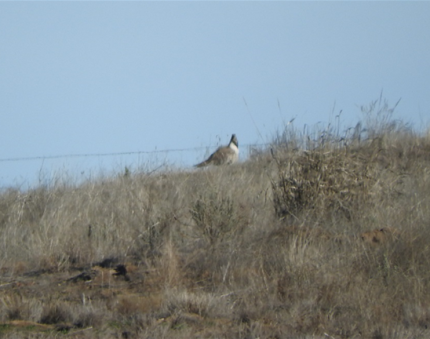
Pronghorn Aerial Survey: Washington Department of Fish and Wildlife Biologists Jeffreys and Eilers joined Biologist Rushing, a wildlife biologist for the Confederated Tribes of the Colville Reservation (CTCR), in performing an aerial survey for pronghorn across Douglas County.
Pronghorn were extirpated from Douglas County by the late 1800s. The Confederated Tribes of the Colville Reservation introduced 52 pronghorn to the Colville Reservation in 2016, and 98 in 2017, many of which swam across the Columbia River to Douglas County. The pronghorn they introduced were from Nevada.
A minimum of 103 individual pronghorn were observed during the aerial survey, predominantly in the Sim’s Corner and Leahy Junction areas. Surveys conducted on the Colville Reservation the week prior found approximately 120 pronghorn. For more information on pronghorn in Washington, visit the Washington Department of Fish and Wildlife website at: Pronghorn Antelope | Washington Department of Fish & Wildlife.
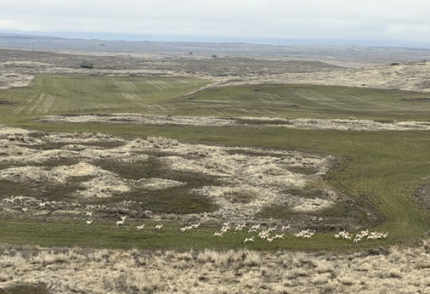
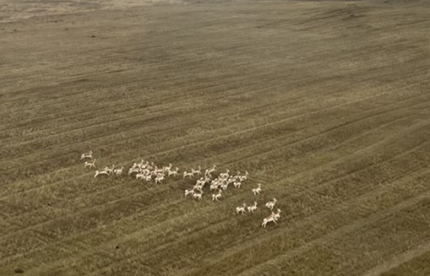
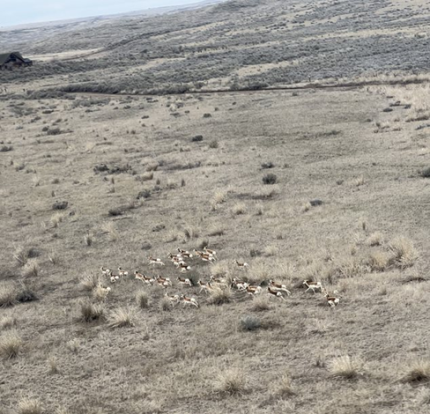
Mule Deer Collars: Hunter Education Coordinator Montanari retrieved one additional GPS collar from a mule deer to download the data that was stored onboard. Between 2020 and 2022, more than 60 does were collared in Chelan County as part of an ungulate movement and migration study being conducted in several Washington herds as well as across the western United States. Biologists have used location data gleaned from these GPS collars to learn valuable information about timing and duration of migration, migratory corridors and stopover points, and winter and summer range use for mule deer wintering in the Wenatchee Foothills as well as the Nahahum Canyon, Burch Mountain, and Swakane areas.
These collars were programmed to drop off in four years after deployment, so the last 12 collared does still standing since the January 2020 capture dropped their collars as scheduled last month. Biologists have recovered four of these collars so far and will continue to go after the other eight in the coming months. Washington Department of Fish and Wildlife will continue to receive GPS data from the approximately 13 collars still active on does in Chelan County for two more years.
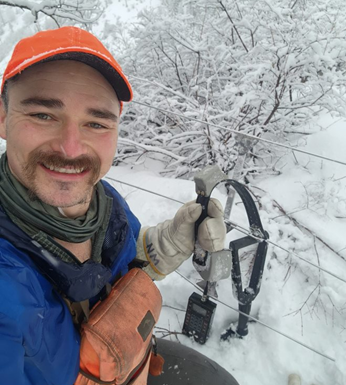
Pygmy Rabbit Surveys: Biologist Morris helped with more pygmy rabbit surveys. The lack of snow on the ground made surveys more difficult, but some burrows in a known occupied area showed activity. A lot of cottontails were also seen.
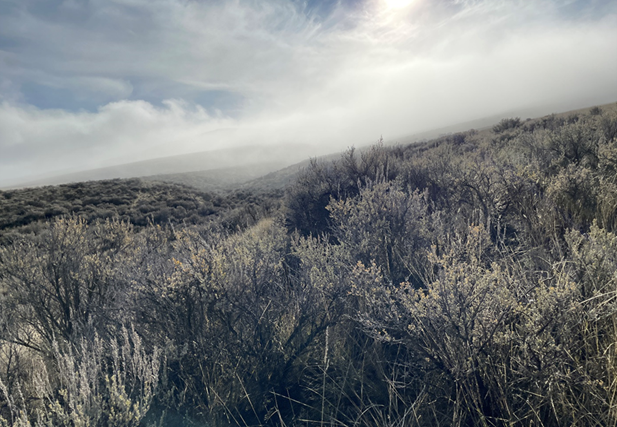
Mule Deer Methow Winter Range Closure: The Methow Wildlife Area winter range closure is still in effect until April 1. Even though it’s been an unseasonably mild winter and early spring, collar data shows migratory mule deer are still on their winter ranges. For example, staff members counted over 85 mule deer at the Golden Doe last week and collar data shows deer congregating in the shrub steppe area that recreationist tend to prefer. Staff members have been counting nearly 50 deer at Lewis Butte on a fairly regular basis, which is a huge increase from years past. Staff members also noticed increased deer use at Rizeor Lake and even saw a cow moose and her calf utilizing the closure area. Deer seem to be moving into the spring green up areas of the Big Buck in larger numbers the last few weeks. In summary, by reducing human disturbance at this critical time of year, the closure is proving beneficial to the Methow’s beloved and iconic herd of mule deer.
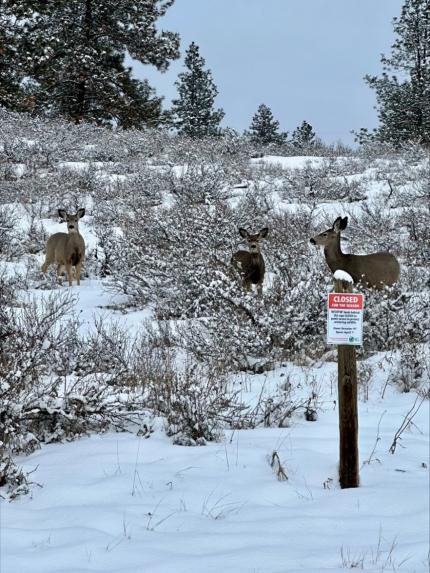
winter range closure boundary.
Providing Recreation Opportunities
Hunter Access: Biologist Morris checked fields enrolled in our Waterfowl Habitat and Access Program (WHAP). The late white goose season is currently open and ends at the end of the week.
Biologist Morris completed two Hunter Access contracts that landowners wanted to renew, one Hunt by Written Permission and one Feel Free to Hunt.
Providing Conflict Prevention and Education
Wolf Deterrence Outreach: Specialist Heilhecker and Wildlife Regional Program Manager Haug visited with Okanogan Conservation District staff members to discuss nonlethal wolf deterrence measures. They discussed wolf activity in the county and how to get the message of nonlethal deterrence measures out to the local community.
Radio Activated Guard Deployment: Specialist Heilhecker deployed a Radio Activated Guard (RAG) box near cattle feedlots and calving pens. Wolves were coming close to the feedlots due to an open carcass pit. The producer buried the carcass pit. The wolves continued to come to the buried pit for the following eight days before it tapered off to less frequent visits.
Conserving Natural Landscapes
Habitat Plots: The ground is clear and now it is time to start spring habitat management activities. Biologist Morris spent some time planning spring habitat management projects.
Biologist Cook visited two landowners in Grant and Adams counties to discuss options of habitat improvement. Potential projects include irrigated and non-irrigated tree and shrub planting to improve wildlife cover and food sources and stabilize drainage ditch banks. Other projects include no-till native grass seeding to improve stand diversity and Russian olive removal to reduce invasive species and open space for desirable plants. Some shrub replanting may occur this spring depending on nursery stock. Most projects will be implemented this fall or later.
Conservation Reserve Program: Biologist Morris spoke with a landowner about preserving sagebrush that could provide potential pygmy rabbit habitat. The landowner is re-enrolling land in the federally run Conservation Reserve Program and needs to reseed the field. Biologist Morris will recommend leaving portions of the field that contain mature sagebrush since pygmy rabbits occupy fields less than two miles away and could occupy the site in the future.
Part of the reason for preserving sagebrush areas is that it can take 10 to 20 years to get a stand of sagebrush that is mature, dense enough to support pygmy rabbits. Every time mature sagebrush is destroyed it resets the clock for another 10 to 20 years before the area could provide pygmy rabbit habitat again.
Limebelt Forest Thinning: Scotch Creek staff members resumed thinning small diameter trees in the forested portions of the Limebelt on the Scotch Creek Unit. The goals of the thinning are to eliminate conifer encroachment in and around aspen, reconfigure fuels, and restore historical stand densities.
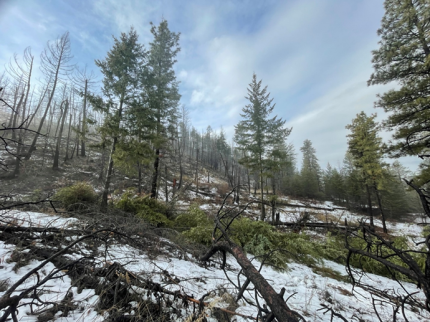
Shrub Enclosure Removal: Scotch Creek staff members removed approximately 2000 feet of temporary deer fence that was installed back around 2010 to protect newly planted deciduous shrubs. In 2015, the Okanogan Complex Fire burnt a portion of the enclosure. The fence was repaired, and new plants were planted in 2016. The fence has reached its life span and most of the shrubs are tall enough to be out of browsing height of deer.
Boundary Fence Repair: Scotch Creek staff members repaired approximately one mile of boundary fence on the Similkameen-Chopaka Unit damaged by high water from the Similkameen River and one mile on the Tunk Valley Unit damaged by falling dead trees from the Tunk Block Fire in 2015.

Providing Education and Outreach
Grant Elementary School Science Fair: Administrative Assistant Jones and Biologists Cook, Morris, Nason, and Technician Balderston organized an outreach room for Grant Elementary School students and their families to learn more about wildlife resources. Mammal skulls and skins, amphibian and reptile skeletons, and an insect coloring and cutout activity were provided for the public. Washington Department of Fish and Wildlife stickers and pamphlets were also available for families.
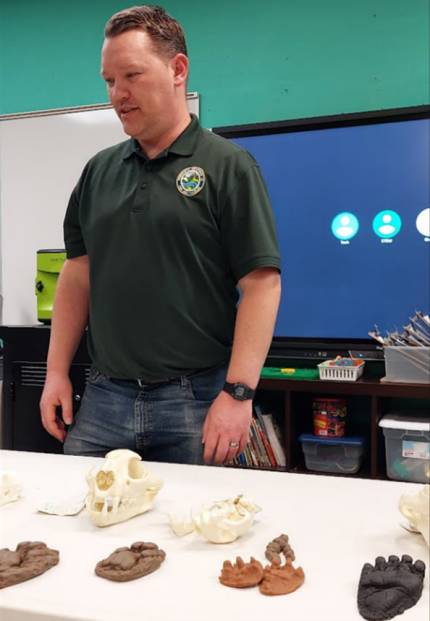


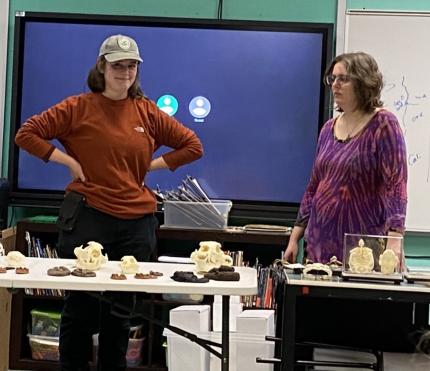

Conducting Business Operations and Policy
Natural Resource Conservation Service Local Working Group Meetings: Biologist Cook attended the West Palouse Local Working Group meeting in Ritzville and Biologist Morris attended the North Central Local Working Group meeting in Chelan. During these meetings, local priorities are decided for ranking Environmental Quality Incentives Program (EQUIP) proposals for the following fiscal year. Cook and Morris provided feedback and suggestions to include terrestrial wildlife habitat as a priority in the Rangeland Improvements Category.
Private Lands Work Party Planning: Private Biologist Braaten worked on planning an upcoming statewide Private Lands work party in north central Washington March 26 through March 28.
Region 2 North Community Collaborations: Assistant Regional Wildlife Program Manager Troyer has recently engaged in a variety of community collaborations. For example, Troyer recently attended the Chewuch Canal Company meeting to discuss future infrastructure improvements that would better serve irrigators, but also conserve more water for in-stream flows. Additionally, Troyer ran into a variety of other Washington Department of Fish and Wildlife colleagues at a Natural Resource Conservation Service workshop in Chelan. Lastly, Troyer has been busy as a core planning team member on Okanogan County’s Community Wildfire Protection Plan efforts.
Other
Damage Claim Processing: Specialist Heilhecker gathered notes and documentation for a deer damage crop compensation claim.
Permit Database Development: Specialist Heilhecker provided comments to a draft users’ manual for the new damage permit database system.
Wildlife Observed: While out checking local conditions Biologist Morris spotted several swans and bald and golden eagles, in agricultural fields near Quincy.
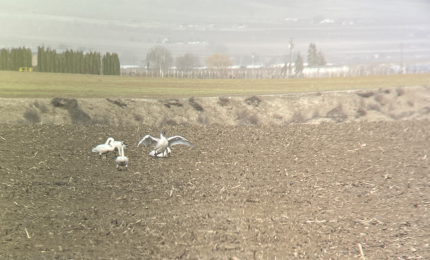
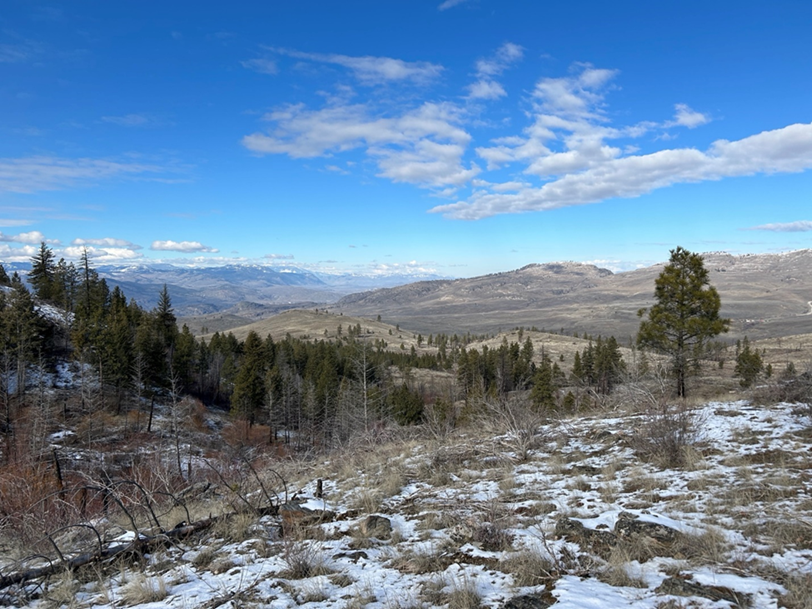
Managing Wildlife Populations
L.T. Murray Winter Vehicle Restricted Area: L.T. Murray Wildlife Area Natural Resource Scientist Nass closed the gate on Cayuse Creek to complete the annual winter closure to vehicles on the Whiskey Dick Unit. On the Feb 1. closure date, Washington State Parks denied wildlife area staff members entry through the lower elevation Washington State Parks gate off Recreation Drive because soft wet roads could lead to resource damage and the Washington State Department of Fish and Wildlife access roads were blocked by snow drifts.
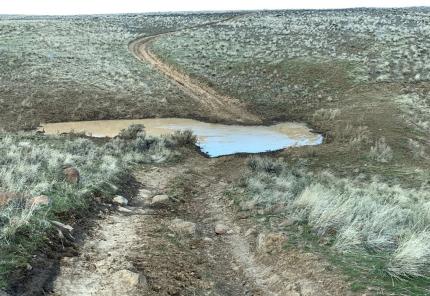
L.T. Murray Bird Boxes: L.T. Murray Wildlife Area Natural Resource Technician Blore and Assistant Manager Winegeart checked nine kestrel boxes near Parke Creek on the Quilomene Unit. Three boxes contained kestrel feathers, and all the boxes had been used. Most boxes had nesting material added to them indicating use from other species.
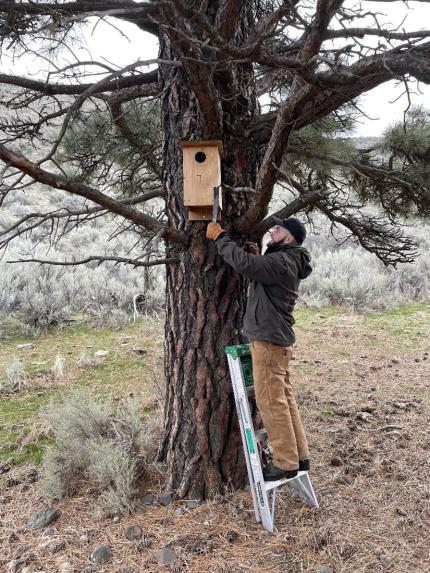
Oak Creek Wildlife Area Elk Feeding Operations: Oak Creek Wildlife Area staff members continue to conduct feeding operations at the Cowiche Unit and Oak Creek Unit feed sites. With mild winter weather and an early spring, elk have started to leave the feed sites and forage elsewhere. Daily elk counts fluctuate based on weather and movement of elk but total counts on the Cowiche Unit have reduced from 2200 in the middle of February to an average of 600 at the end of February. Total elk counts at the Oak Creek feed site have reduced from 600 in the middle of February to an average of 250 at the end of February. Daily monitoring of elk indicates elk are in seasonable good health.
District 4 Ferruginous Hawk Mitigation Impacted by Proposed Windfarm: District 4 Wildlife Biologist Fidorra removed two nesting platforms from private lands that had been installed as part of a mitigation project. The land is under contract with the Horse Heaven Hills Windfarm and the developer requested the platforms be removed. New sites should be identified to relocate these platforms.
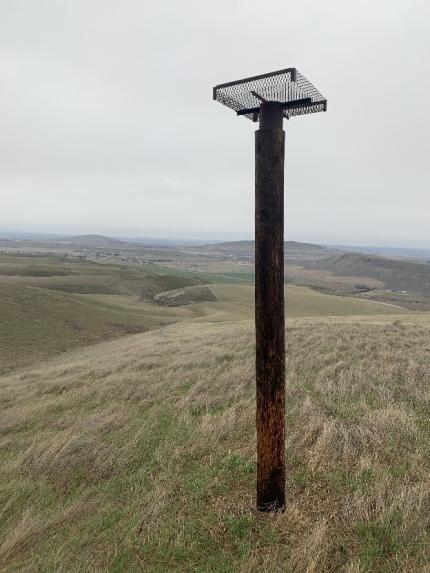
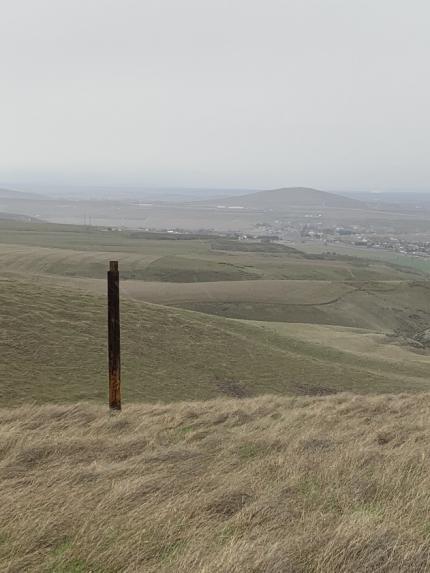
Burrowing Owls Overwinter in Tri-Cities at Habitat Project: District 4 Wildlife Biologist Fidorra and Assistant Wildlife Biologist Hoffman checked and maintained artificial burrows for burrowing owls. Mild weather this winter allowed many owls to overwinter successfully, with a large number of birds already on breeding sites during February maintenance checks. Recapturing these owls provides important data on survival and movements as many were banded individuals from the regional population.
Over-wintering owls is a unique phenomenon in the Columbia Basin as most of the western subspecies are migratory. In most years, most females and juvenile birds migrate south to California and Mexico, but some hardy adult males tend to overwinter. It appears females and some younger birds skipped migration this season!
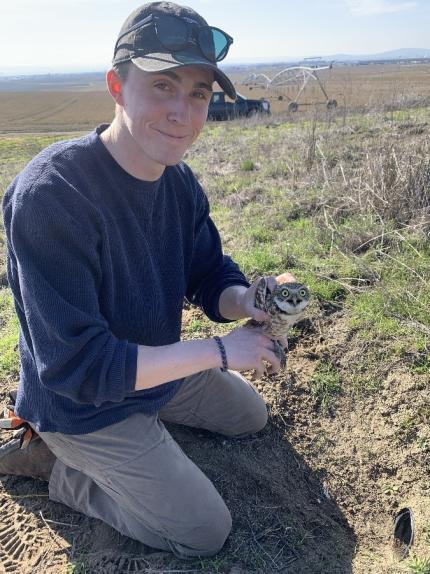
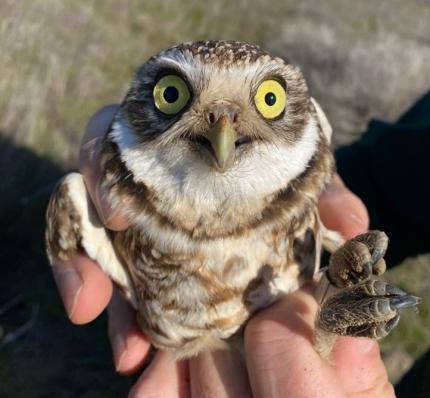
City of Pasco Installs Artificial Burrows for Burrowing Owls as Mitigation: District 4 Wildlife Biologist Fidorra worked with City of Pasco staff members and contractors to finalize installation of 21 artificial burrows on property where construction was impacting known breeding sites. These new burrows should provide breeding sites for seven pairs of owls, which would be a potential net positive outcome for the local owl population! Fidorra and City of Pasco staff members will monitor the burrows for success.
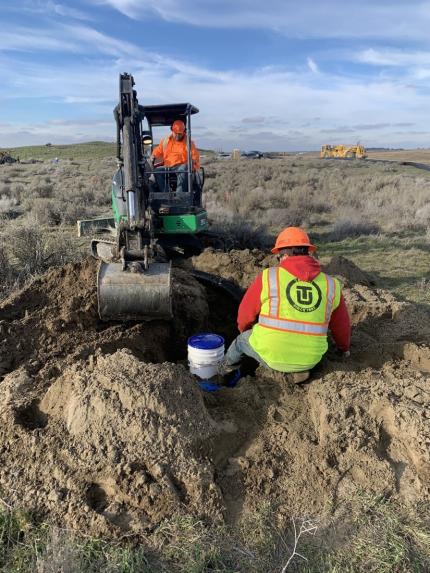
District 8 Bighorn Sheep Collaring: District 8 Wildlife Biologists Wampole and Moore alongside Ungulate Specialist Moore work together with a contractor Quicksilver to capture and collar, bighorn sheep in the Yakima Canyon and Clemen Mountain herds. Captures took place Feb. 16 through Feb. 18. Data entry and shipment of biological swab and blood samples also occurred.
District 8 Kittitas County Deer Collars: In Kittitas County, District 8 Wildlife Biologists Wampole and Moore continue to pick up dropped deer collars from Washington Department of Fish and Wildlife 2020 mule deer project.
District 8 Trail Cameras: Biologists Wampole and Moore have been picking up trail cameras used for winter wildlife monitoring. This project helps species specialists monitor wildlife populations, growth, and movement.
District 8 Grouse Wing Bee: Assistant District Wildlife Biologist Moore joined other district biologists, and other Washington Department of Fish and Wildlife staff members in Spokane for the department’s annual grouse “Wing Bee”. Biologists are able to determine the species, age, and sex from the plumage characteristics on the wings and tail fans that were collected via the grouse wing and tail collection barrel program.
Providing Recreation Opportunities
Wenas Wildlife Area Manastash Ridge Trails – Trail Conditions Sign Install: Wenas Wildlife Area Lands and Recreation Specialist Frame created, designed, and installed an interactive sign that displays current trail conditions in the area. This sign has an adjustable arrow that indicates if the trails are in good, fair, icy, or poor condition. The arrow is held in place with a lock and pin configuration to prevent unwanted movement of the arrow. This sign idea was suggested by the Manastash Ridge Trails Committee.
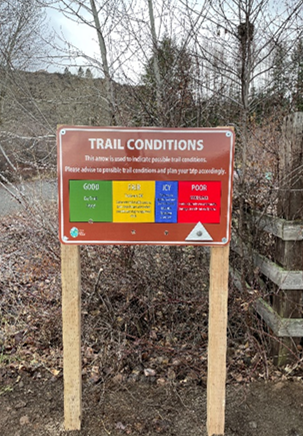
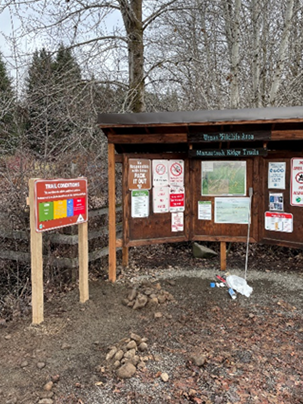
Providing Conflict Prevention and Education
Rattlesnake Hills Elk: District 4 Wildlife Conflict Specialist Hand monitored elk activity on the Hanford National Monument and adjoining private lands. Large numbers of elk continue to occupy low elevation areas near Highway 240 on the Hanford Monument and were hazed away from the roadway.
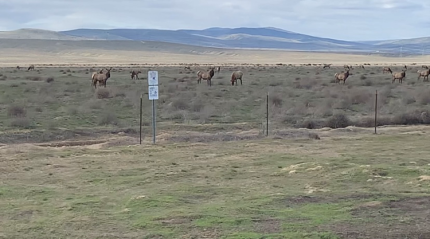
District 4 Pasco Nuisance Deer: District 4 Wildlife Conflict Specialist Hand received and responded to a complaint from a homeowner along the Columbia River in Pasco concerning a small group of deer that have browsed on fruit and ornamental trees and shrubs. Advice on protection measures and hazing strategies were discussed and will be employed to hopefully reduce any damage impacts.
District 4 Kahlotus Deer: District 4 Wildlife Conflict Specialist Hand continued to coordinate deployed youth from the Region 3 special permit roster to landowner’s experiencing deer damage in the Kahlotus area.
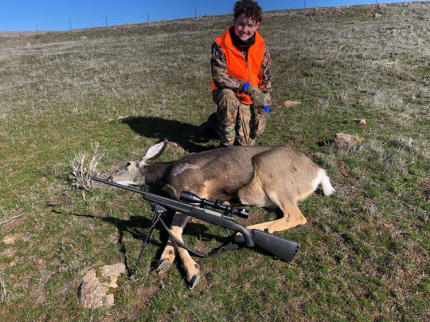
District 4 West Richland Deer Complaint: District 4 Wildlife Conflict Specialist Hand continued to work with a landowner along the Yakima River to address an increasing number of deer causing damage. Two master hunters have been deployed to the property for hazing and removal operations.
District 4 Vehicle Collision with Pronghorn: District 4 Wildlife Conflict Specialist Hand responded to a call of a vehicle collision with a pronghorn antelope along Highway 221 south of Prosser. Biological information was captured and entered in Survey 123.
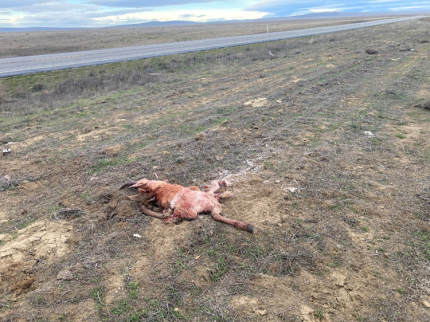
District 8 Kittitas County: Conflict Technician Leuck and Conflict Specialist Wetzel hazed some elk from areas in Kittitas County. Elk ventured to areas in Thorp, Vantage, Kittitas, Badger Pocket, and Cle Elum mostly visiting haystacks and domestic animal feeding areas. Elk have been hazed away again from Interstate 90 in some locations. Wetzel also tasked an agency range rider to work on wolf issues in the Lauderdale to Kittitas area of the old Naneum Pack territory.
District 8 Yakima County: Conflict Technician Leuck and Conflict Specialist Wetzel repaired elk fence at the return gate and another location in the Cowiche area where elk were in orchards outside the elk fence. Elk were hazed from Tampico and the Tieton areas as well.
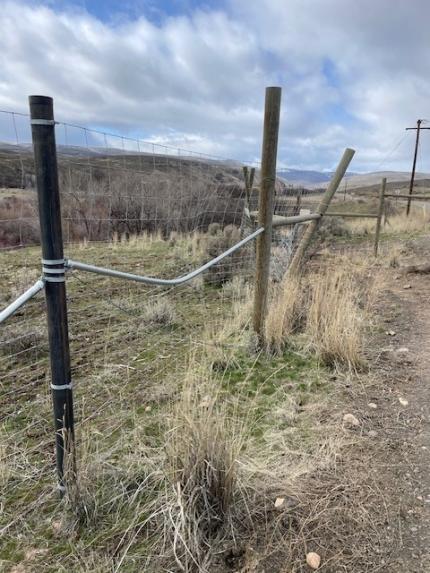
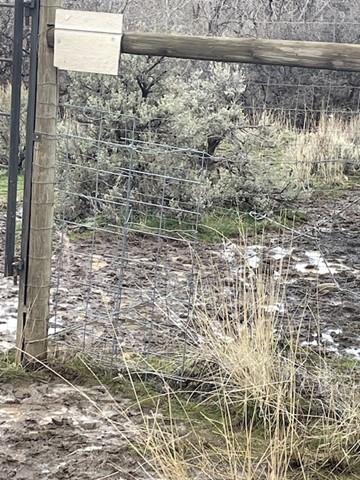
Conserving Natural Landscapes
Quilomene Watershed: Natural Resource Technician Blore continued working with Assistant Area Habitat Biologist Shaffer to either replace a Parke Creek tributary culvert or convert the site to a ford.
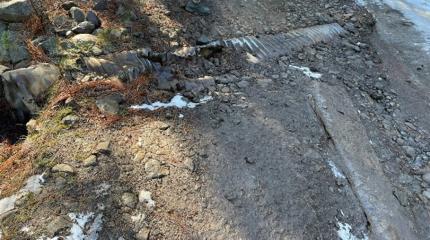
Wenas Wildlife Area Bull Pasture Rd / Bell Tell Rd – Illegal Trash Dump Clean Up: Wenas Wildlife Area Lands and Recreation Specialist Frame and Wenas Wildlife Area Natural Resource Technician Janes cleaned up an illegal trash dump on the Wenas Wildlife Area. The trash was partially burned and spread over the ground. Frame and Janes discovered multiple pieces of trash with names and addresses that may lead to who dumped the trash. Those pieces of evidence were submitted to Washington Department of Fish and Wildlife Enforcement. A total of 210 pounds of trash was removed from the site.
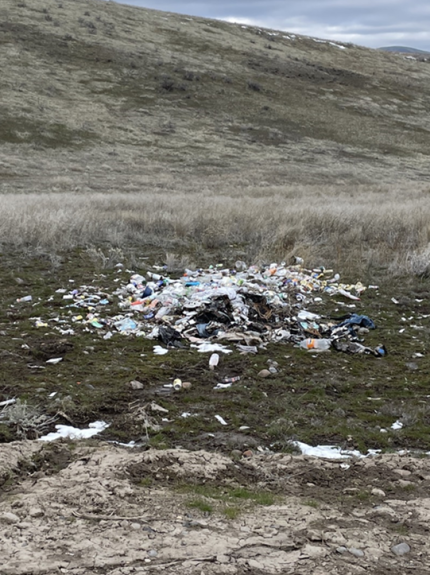
Wenas Wildlife Area Grazing: Wenas Wildlife Area Manager Gray met with a grazing lessee to review how last season’s grazing went throughout the unit. The lease was designed to help improve habitat and maintain positive relationships within the community. Gray discussed the need for a future lease with the lessee and will be working on doing another lease this coming season.
Neff Jones Road Hunt By Reservation Site Shrub Monitoring: Private Lands Biologist Manderbach checked on a shrub planting done about a year ago by then Natural Resource Technician Manderbach and former Private Lands Biologist Hulett on the Neff Jones Private Lands Access site. The sagebrush that was planted is doing well and growing, but the antelope bitterbrush had a very low success rate. Notes were taken on what went well and what could be improved upon for future habitat work at that site.
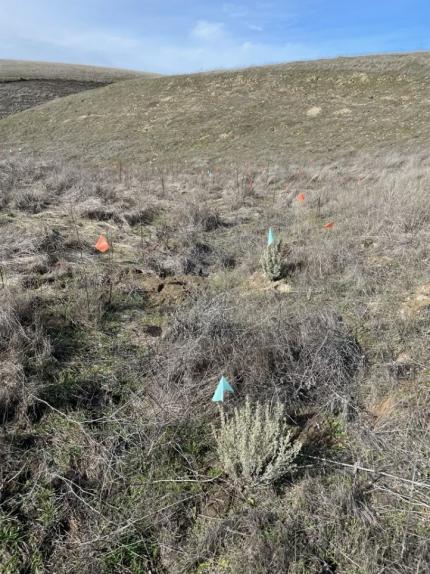
Sunnyside-Snake River Wildlife Area Byron Unit Sagebrush Planting: Sunnyside-Snake River Wildlife Area staff members and District 4 Assistant Biologist Hoffman planted sagebrush plugs using hand drills with auger attachments in late February. This is a new technique and seems very efficient. The sagebrush is being planted as part of a restoration effort to replace sagebrush lost to a fire that occurred there in 2022.
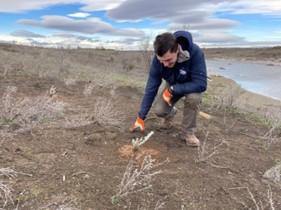
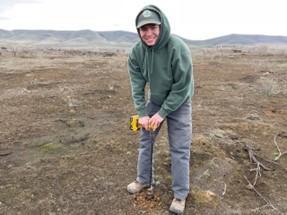
Providing Education and Outreach
L.T Murray Hunter Education: The Kittitas County Field and Stream Club held two Hunter Education classes at the Green Gate subunit of the Quilomene Unit on the L.T. Murray Wildlife Area. More than 40 students participated and earned their Hunter Education Certificate.
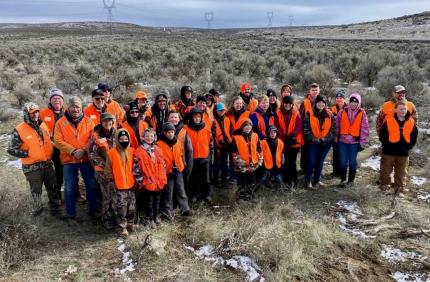
Rosalind Franklin Elementary STEM Night: Private Lands Biologist Manderbach setup a pelts and skulls table for the Rosalind Franklin Elementary STEM Night in Pasco. Students and parents both were intrigued by all of the pelts and skulls and had many questions. The elk antlers were a big hit.
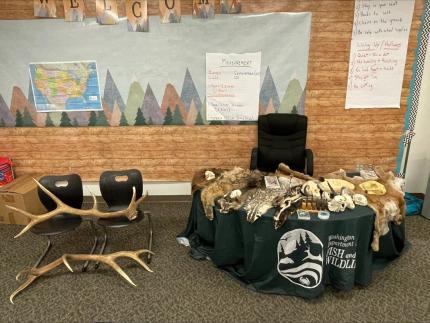
Central Washington Sportsmen Show: Private Lands Biologist Manderbach worked the booth at the Central Washington Sportsmen Show for the first time. There were many questions answered about all things fish and wildlife, but not many that were specific to private lands access.
Conducting Business Operations and Policy
Wenas Wildlife Area Bonneville Power Contract: Wenas Wildlife Area Habitat Specialist Miller started the process of renewing the Bonneville Power Administration contract for the wildlife area. This contract is essential to the wildlife area for maintaining an operating budget. Bonneville Power Administration funds comprise a majority of the Operations and Maintenance Budget for the wildlife area.
Other
L.T. Murray New Spray Tanks: Natural Resource Technician Blore assembled a couple 45-gallon spray tanks on small trailers to be used to transport as extra water to water planted shrubs or refill spray tanks.
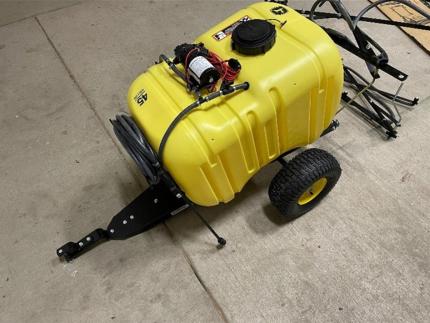
Oak Creek Wildlife Area Elk Fence Repair: Oak Creek Wildlife Area Assistant Manager Charlet, Natural Resource Technician Stoltenow, and Natural Resource Worker O’Brien repaired a section of elk fence that was damaged by a Utility Terrain Vehicle (UTV) that lost control. Damage included multiple leaning or broken posts and a large hole in the fence that elk could easily pass through.
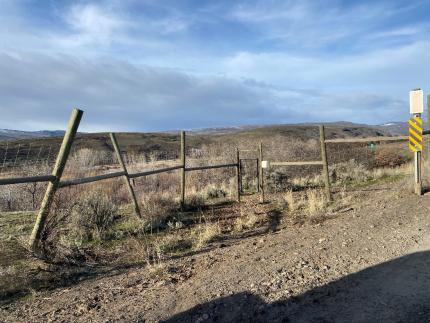
Managing Wildlife Populations
Dusky Canada Goose Surveys: Biologist Wickhem conducted two dusky Canada goose surveys on the Shillapoo Wildlife Area and surrounding lowlands of Clark County this month. Biologists Stephens and Holman conducted the twice-monthly surveys in Cowlitz and Wahkiakum counties. Dusky geese are a sub-species of Canada goose that spend summers in Alaska and migrate through and/or overwinter in the lower Columbia River. Duskys are closed to recreational harvest due to low population levels. The purpose of the surveys is to count dusky geese observed and read alphanumeric codes on any red-collared duskys. Wildlife managers survey the geese multiple times across their primary wintering grounds and use the data to generate survival estimates.
During her second February survey, Wickhem recorded 288 dusky geese and read eight red neck collars. Surprisingly, only two collars were repeats from the previous week and the rest were new records for this season. That makes a total of 20 individual collars recorded so far at Shillapoo Wildlife Area for the 2023-2024 season.
Other notable sightings included the first swans of the season, red-tailed hawks, northern harriers, bald eagles, great blue herons, egrets, sandhill cranes, snow geese, many species of waterfowl, and coyotes. Thanks to retired Biologist Miller for assisting on the Cowlitz County survey during this time period.
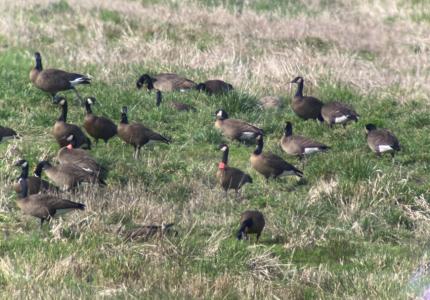
Cougar Pelt Seal: Wildlife Conflict Specialist Jacobsen sealed the pelt of an adult female cougar for a successful cougar hunter in GMU 388.
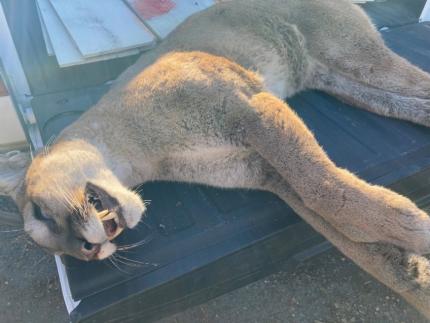
Bobcat Pelt Seals: Wildlife Conflict Specialist Jacobsen sealed four adult bobcat pelts for a bobcat trapper/hunter. The bobcats were harvested in GMUs 578, 388, and 382. The Convention on the International Trade of Endangered Species (CITES) regulations require that pelts of certain species legally harvested (such as bobcats and river otters) be tagged with a department-issued federal CITES tag.
CITES is an international agreement between governments which aims to ensure that trade in specimens of wild animals and plants does not threaten their survival. Many wildlife species that are subject to trade are not endangered, but the existence of an agreement to ensure the sustainability of the trade is important in order to safeguard these resources for the future. The pelts of the bobcats harvested by this individual will be sold to the fur market in the upcoming months.
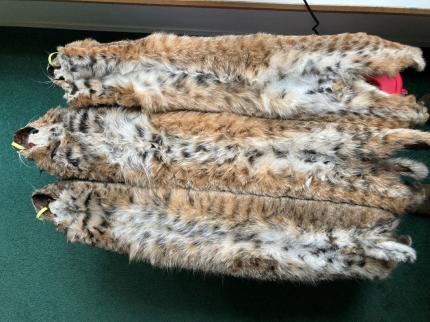
Deceased Deer: Wildlife Conflict Specialist Jacobsen helped a landowner dispose of a dead deer in his yard in an urban area of Klickitat County. It is unknown how the deer died.
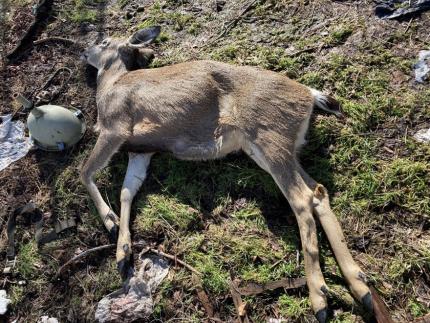
First Injured Deer: Wildlife Conflict Specialist Jacobsen responded to a report of an injured deer on the side of the road in Klickitat County. The deer ended up expiring before Jacobsen arrived at the scene. Jacobsen moved the deceased deer out of the roadway.
Second Injured Deer: Wildlife Conflict Specialist Jacobsen responded to a report of an injured deer that had been unable to get up for the past 24 hours. Jacobsen assessed the deer and determined that she was unable to use her back legs and needed to be euthanized. Jacobsen euthanized the deer and the landowner disposed of the carcass.
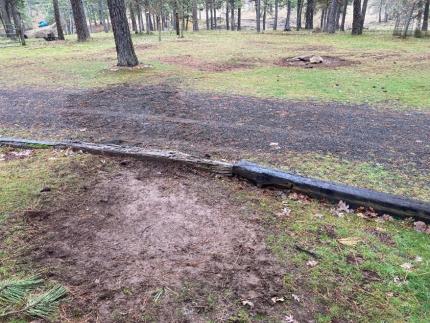
Deceased Bald Eagle: Employees at The Dalles Dam contacted Wildlife Conflict Specialist Jacobsen regarding a dead bald eagle near a popular eagle roosting spot on dam property. Jacobsen responded to the scene and took possession of the eagle. Jacobsen will send the eagle in for testing of avian influenza (HPAI) and lead poisoning.
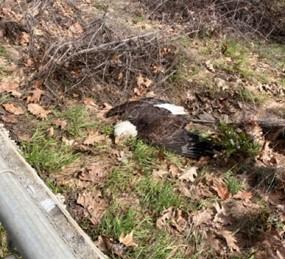
Providing Recreation Opportunities
Massey Bar Access Area: Access area staff members were pleased to see that the Capital Asset Management Program (CAMP) promptly started grading Region 5 access areas as soon as they received the road and parking grading list. In the past, Region 5 has been the last region to be visited. This is a much-appreciated change and is great for our staff and anyone who uses these sites.
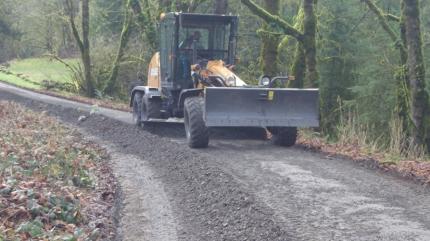
Providing Conflict Prevention and Education
District 9 Livestock Carcass Disposal: Wildlife Conflict Specialist Jacobsen received a report of a dead cow at a livestock producer’s operation. To help prevent wolf scavenging on livestock carcasses near active calving operations, Jacobsen hauled the carcass away from the operation and disposed of it at a regional landfill.
District 9 Chicken Depredations: A concerned landowner contacted Wildlife Conflict Specialist Jacobsen regarding hawks depredating on his chickens in Clark County. After talking to the landowner, Jacobsen learned that the landowner had several hundred chickens that he allows to free-range on his property. Jacobsen discussed the predation risks of having free-ranging fowl (especially that many) and offered several suggestions of ways to help reduce the chicken losses, though free-ranging chickens will likely always experience some level of raptor or mammalian carnivore predation.
District 9 “Poisoned” Coyotes: Wildlife Conflict Specialist Jacobsen worked with Officer Bolton to respond to a complaint about someone “poisoning” coyotes in the neighborhood. The reporting party had found three deceased coyotes in her barn and thought she had seen two more that appeared to be in very poor condition. The reporting party believed that a nearby ranch had been poisoning the coyotes. After talking to the reporting party, who described the coyotes’ plight as “looking like Wiley Coyote, the cartoon,” Jacobsen deduced that the reporting party had been seeing coyotes with severe mange infections caused by a microscopic mite. Jacobsen advised the reporting party that the now-hairless coyotes likely died during the sub-zero temperature cold snap due to their inability to stay warm. Jacobsen and Officer Bolton agreed that poisoning was not a likely scenario given the circumstances.
District 9 Cougar Concerns: Wildlife Conflict Specialist Jacobsen fielded several reports of cougar sightings in GMUs 574 and 578. Jacobsen provided advice on living in cougar country to the reporting parties.
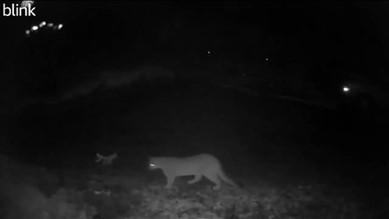
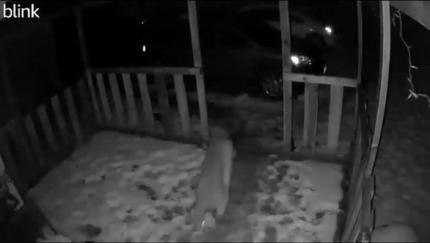
Tree Damage from Squirrels: Wildlife Conflict Specialist Jacobsen received a report of western gray squirrels damaging Douglas fir trees in Klickitat County. Jacobsen provided advice, including advising the reporting party to stop feeding the squirrels in their yard.
Sheep Depredation: Wildlife Conflict Specialist Jacobsen responded to a report of a cougar depredation on a sheep in Clark County. Jacobsen conducted a necropsy of the carcass and determined that the sheep was killed by coyotes. Jacobsen provided advice to the producer on locking his livestock up at night and purchasing a livestock guardian dog to protect his remaining livestock in the heavily-wooded pasture where they were kept.
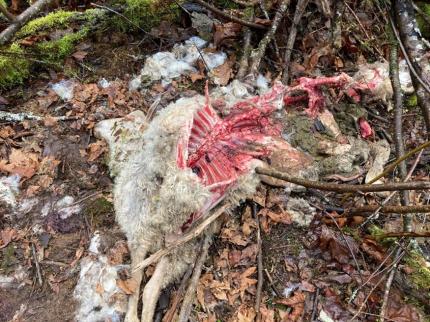
Elk Damage to Crops: Wildlife Conflict Specialist Jacobsen met with a producer who had been incurring elk damage to her commercial organic herb farm. Jacobsen discussed enrolling the producer in a Damage Prevention Cooperative Agreement to help mitigate elk damage to the crops. Jacobsen inspected the damage and documented extensive elk trampling and compaction of the producer’s high-value skullcap crop. While examining the damage, Jacobsen and the producer observed approximately 75 to 80 head of elk in the field. Jacobsen hazed the elk out of the field using 12-gauge cracker shells launched from his shotgun.
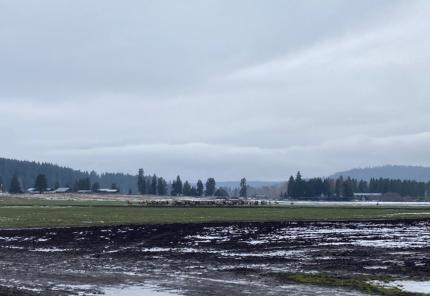
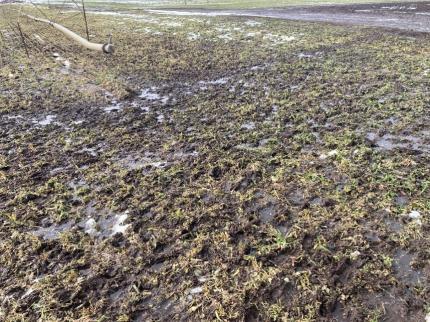
“Bear” Tracks on the Beach: Wildlife Conflict Specialist Jacobsen responded to a report of bear tracks along a popular Columbia River beach. The reporting party sent photos of the tracks to Jacobsen, who confirmed the tracks to be from a domestic dog or coyote.
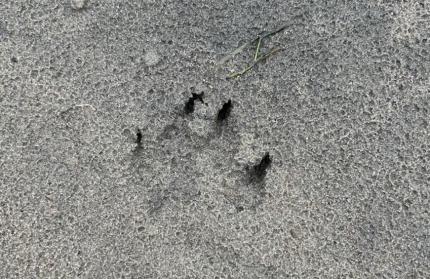
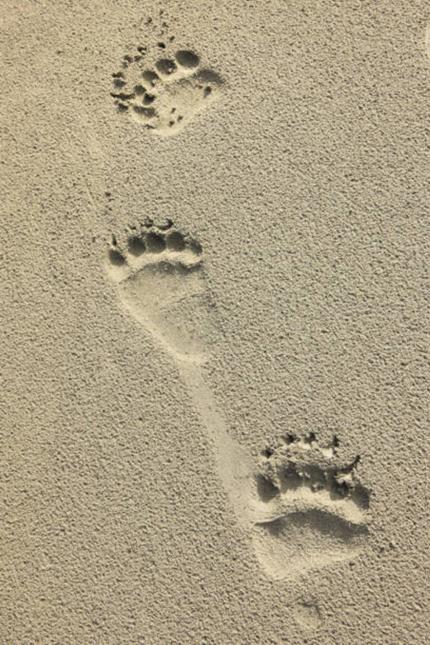
Deer Hoof Damage: Wildlife Conflict Specialist Jacobsen was first notified of a deer with a hoof abnormality in early fall of 2023 in the Carson area. Around mid-spring 2023, the deer had stepped on some sort of plastic ring or cap and it had gotten caught on the deer’s hoof. Over time, the ring worked its way up one of the deer’s toes and began to impede the deer’s movement. Jacobsen made several attempts to catch the deer in the fall and winter of 2023 to no avail.
On March 1, the deer hung around its favorite residence long enough for Jacobsen to make the hour-long trek there, prepare his immobilization equipment, and successfully chemically immobilize the deer. At that point, the deer had ceased to use its rear leg with the plastic ring and its toes had become elongated. The hoof and lower leg tissue also began growing over and encasing the plastic ring to the point where the ring was almost completely concealed. Jacobsen performed field surgery on the deer and carefully removed the ring and some of the necrotic tissue around the lower leg.
The reporting party confirmed the following day that the deer was back to her normal routine and appeared to be using her leg a little more than before. Due to the extent of the injury, it will be quite some time before the deer recovers enough to bear weight on the rear leg.
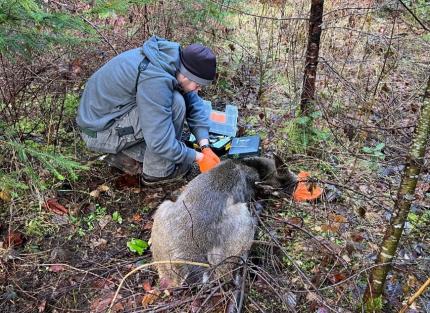
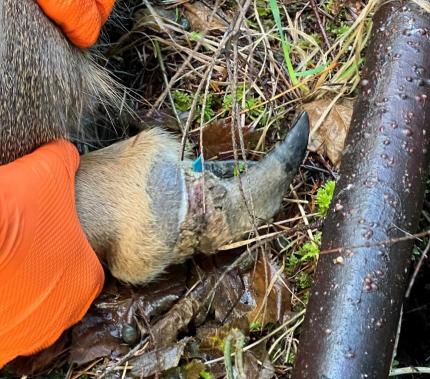
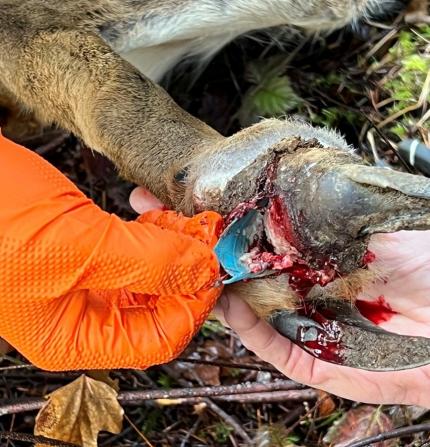
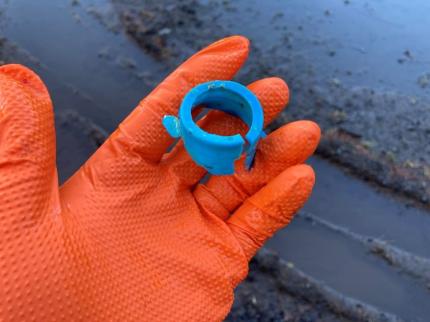
Conserving Natural Landscapes
A Not-So-Happy Valentine’s Day Balloon: Balloons can be a fun way to celebrate a special occasion with loved ones but are not fun for wildlife! On Feb. 15, Technician Crane found this Valentine’s Day balloon at the Vancouver Lake Unit of the Shillapoo Wildlife Area. Thankfully, this balloon was removed and properly disposed of before it could cause any harm. When a balloon floats away, it must eventually come down, often miles from where it was released, and becomes litter. Littered balloons pose a threat to wildlife either when consumed or when animals become entangled in the balloon string. Properly dispose of all balloons or consider other options for celebrations such as eco-friendly confetti or a banner made from recycled material.
Wildlife Conflict Specialist Jacobsen also found a deceased Valentine’s Day balloon on March 1 along the Lewis River. It appeared to have died without much suffering.
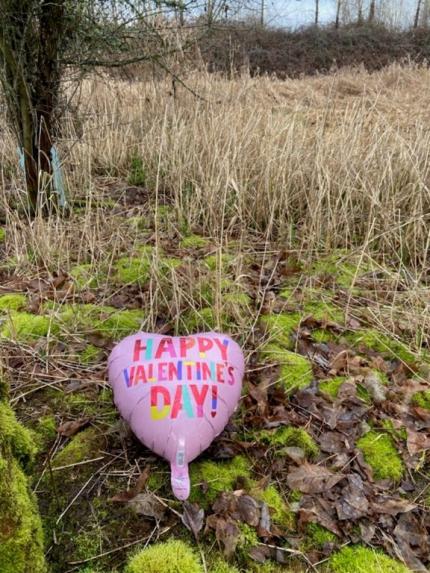
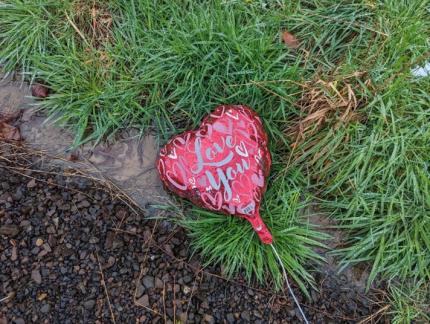
Providing Education and Outreach
Sportsman’s Show: Region 5 staff members from Wildlife, Fish, Habitat, Customer Service, Enforcement, and Hunter Education worked shifts at the Washington Department of Fish and Wildlife (WDFW) booth at the Northwest Sportsman’s Show in Portland in mid-February. The crew answered questions from show attendees, handed out WDFW swag and informational pamphlets, and had a spinning wheel of trivia questions and a shooting video game for kids.
The show was well-attended and had many relevant vendors and programs. Popular questions fielded by WDFW staff members included dates for release of 2024 hunting and fishing pamphlets, cost and license structure for non-residents, the recently held smelt dipping season, 2024 salmon run forecasts, and inquiries regarding the future of hunting season structure in Washington.
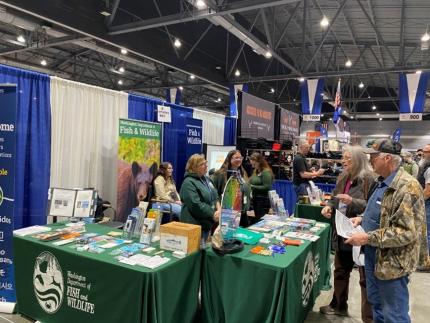
Other
Not the Wildlife We Had in Mind: The annual “fence rip-out and replace” has begun at Shillapoo Wildlife Area which requires many hands and many hours. Unfortunately, work on the first section of fencing had barely begun when it was stalled by a lost visitor. A rather sad looking non-native canine species was found wandering on the wildlife area, presumably dumped by owners that no longer wanted to care for him.
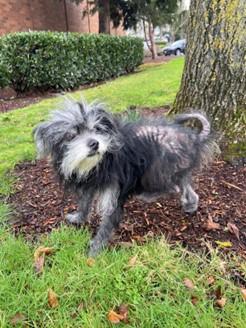
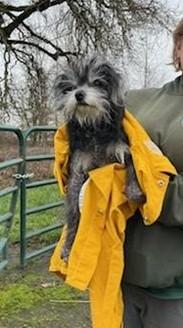
Nicknamed Franklin by wildlife area staff members, this little dog was deaf, blind, and covered from head to toe with a severe case of mange. Franklin was fed some delectable dog biscuits and kept safe by wildlife area staff members until Clark County Animal Control Services could arrive and transport him to the SW Washington Humane Society.
Sadly, finding abandoned pets is NOT an uncommon thing for wildlife area staff members. Franklin is the fifth dog found on the wildlife area this month. There are a variety of options offered in southwest Washington that help owners find new and loving homes for their pets. Dumping pets should never be an option.
Managing Wildlife Populations
Goose Surveys: Biologist Cent and Novack conducted their bi-monthly surveys of dusky Canada geese across Grays Harbor and Pacific counties.
Olympic Peninsula Technical Elk Meeting: District 17 Biologists Novack and Cent attended a coordination meeting with tribal and non-tribal representatives regarding elk management and monitoring on the Olympic Peninsula.
Marbled Murrelets: Biologist Tirhi assisted with the murrelet captures on four separate occasions and was involved in the capture of 3 of the 5 total marbled murrelets captured for the research project (and one ancient murrelet). Marbled murrelets are a state and federally listed species. This study was designed to capture marbled murrelets for prey diet research and is funded by the U.S. Navy.
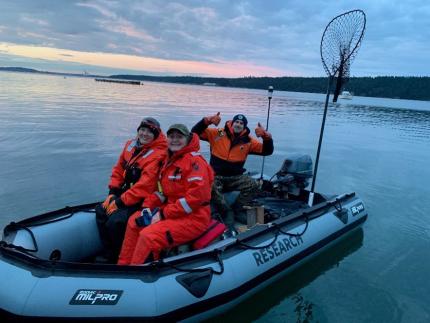
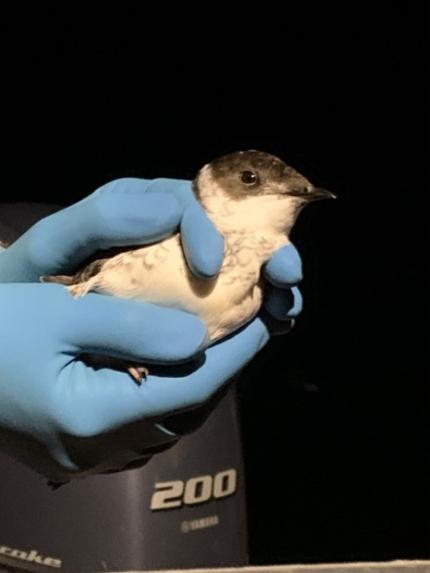
Oregon Spotted Frog: The frog season is off to a slow but steady start across south Puget Sound. Biologist Tirhi has spent several days conducting early season surveys including at the Salmon Creek breeding site where the first ten egg masses were recorded. Tirhi has also spent time mapping out wetlands across four focal areas of Thurston County and researching land ownership and access permission in order to conduct the 2024 surveys.
Conserving Natural Landscapes
Protection Island Restoration: Wildlife Area Manager Laushman and Technicians Morgan and Norris visited the Zella Schultz Unit on Protection Island for ongoing restoration work. They seeded native species and applied herbicide to germinating invasive species on the island.
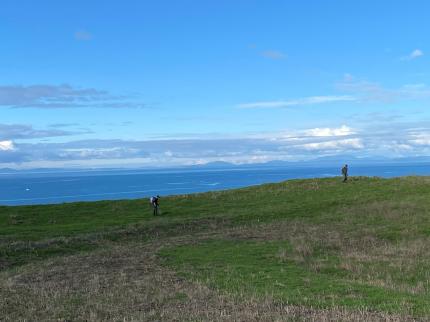
South Puget Sound Weed Control: Technician Morgan continued mowing of Scotch broom on the northern hillsides at the South Puget Sound Unit in Lakewood and cleared thick areas of Scotch broom near the Lakewood Hatchery. Wildlife Area Manager Laushman treated patches of spurge laurel and poison hemlock.

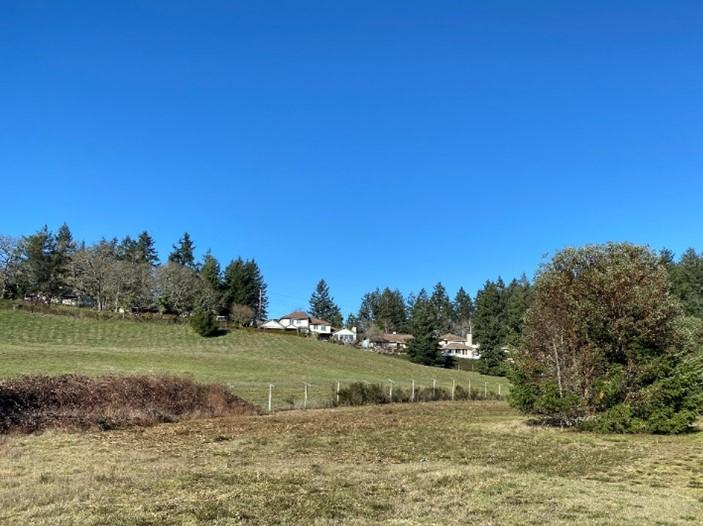
Region 6 Office Wetlands Restoration: Biologists Novack and Cent, along with wildlife area technicians and customer service staff members, planted willow stakes in the wetland area behind the regional office in Montesano. The wetlands are overrun with exotic reed-canary grass and yellow-eyed iris which prevents natural succession. Protective wiring was installed around the planted willows to prevent deer and beaver damage during initial establishment.

Prairie Species and Oregon Spotted Frog land protection: Biologist Tirhi spent considerable time working with Land Protection Lead Frediani on creating a GIS mapping tool to prioritize land acquisition and conservation priorities for Thurston County. Tirhi and Frediani met individually with U.S. Fish and Wildlife Services, Thurston County, and Washington Water Trust to showcase the tool and discuss partnerships for implementation. This partnership will continue and will use various funding sources to acquire or otherwise protect lands for these priority species.
Providing Education and Outreach
Puyallup Sportsman Show: Biologist Tirhi covered one shift at the annual sportsmen show held at the Puyallup fairgrounds.
Conducting Business Operations and Policy
Capital Project Proposal: Biologist Novack, working in conjunction with Wildlife Area Manager Bechtold and Kronland, submitted a proposal for removing derelict structures on the Chehalis and Davis Creek units concurrent with constructing an ADA accessible observation platform at Davis Creek.
Tracked All-Terrain Vehicle (ATV): Biologists Butler and Tirhi spent several hours cleaning out a donated space at one of the Washington Department of Fish and Wildlife fish hatcheries for the storage of the district’s tracked ATV used for winter surveys and monitoring. The desire was to move the machine from the open into an enclosed area to prevent rust. District 11 is grateful to the Hatchery Program for allowing the use of the space.
